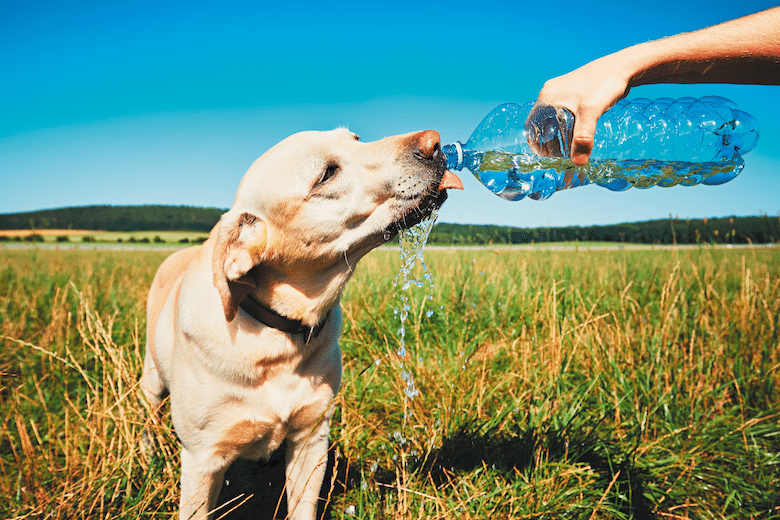The post How to Keep Your Dog Safe During the Wildfires by Beth Ann Mayer appeared first on Dogster. Copying over entire articles infringes on copyright laws. You may not be aware of it, but all of these articles were assigned, contracted and paid for, so they aren't considered public domain. However, we appreciate that you like the article and would love it if you continued sharing just the first paragraph of an article, then linking out to the rest of the piece on Dogster.com.
Wildfires have swept through the West Coast, affecting air quality across the country. Humans aren’t the only ones we need we need to worry about. Smoke inhalation and heat exhaustion can be dangerous to dogs, too.
“Smoke is an air pollutant just like anything else, whether it be car exhaust or fossil fuels. As an air pollutant, all of us, animal or human, should limit our exposure,” says Jennifer Sergeeff, DVM, DACVIM, internist and medical director at BluePearl Speciality and Emergency Pet Hospital in Daly City, California., whose practice and home were in the smoke zone of the fires during their peak.
The consequences of smoke inhalation and heat exhaustion can range from discomfort to death. Dr. Sergeeff shared signs and symptoms to look out for and how to help your pet safely get through a wildfire.

Photo: Getty Images
Can I walk my dog?
Most dogs are trained to potty outside and many get their exercise from walking. Dr. Sergeeff says it’s OK to continue to walk them, but advises proceeding with caution.
“They can go outside for short periods of time to [go potty] on their normal time, but don’t spend an excessive amount of time outside,” Dr. Sergeeff says.
What does excessive mean? There’s no magic number.
“Ten to 20 minutes is probably OK — use common sense,” Sergeeff says. “Don’t take your dog to the beach or dog park and play Frisbee for 45 minutes when the air is red or black.”
Dr. Sergeeff suggests getting walks in before the heat of the day, such as at sunrise and after sunset, to prevent a potentially deadly combination of smoke inhalation and heat exhaustion.
“Panting is the way dogs release heat and so if their lungs are compromised from smoke and it’s excessively hot that can domino together,” she says. “That’s where you can get into serious issues like heat exhaustion.”
Pay close attention to local air quality reports before heading out.
What are the signs of smoke inhalation in dogs?
Dogs who have inhaled smoke may have watery, red eyes, itchy faces, coughing or excessive clearing of their throats and trouble breathing. They may act agitated or have slow reaction time, and some dogs are more at risk for complications.
“Animals who may have pre-existing lung or heart disease may be prone to worsening cough, wheezing, almost asthmatic-like symptoms,” Dr. Sergeeff says.
Breathing difficulty may get gradually worse during the first 24 hours following smoke inhalation.

To prevent your dog collapsing from heatstroke, make sure cool water is always available. Photo: Getty Images
What are the signs of heat exhaustion?
Particularly in California, where the wildfires coincided with near-100-degree Fahrenheit weather, pet parents also need to be aware of heat exhaustion.
“The main [signs] we see are they will start panting, usually because they are trying to dispel heat,” Dr. Sergeeff says. “Then they may get bright red gums. They could collapse. They might drink a lot of water and vomit it up. We often see them start to stumble.”
What to do if you think your dog has an issue
Even if you take precautions, your dog may inhale smoke or suffer from heat exhaustion — you can only control so much when Mother Nature is involved. Take steps to help your dog quickly. If you’re exercising and the dog is displaying signs of heat exhaustion, stop the activity. Then, help your dog cool off.
“If you’re at home, one thing you can do, you can put them in the back and hose them down,” Dr. Sergeeff says. “That’s conductive cooling and then seek veterinary attention. A lot of times, they will need to be stabilized and more actively cooled.”
The vet can help dogs suffering from smoke inhalation with oxygen therapy, but some may need to be intubated, a procedure that involves placing a tube in the mouth and down to the trachea to keep the airway open.
Be careful of wildlife
Unfortunately, smoke inhalation and heat exhaustion aren’t the only issues with going outside. Predatory animals, like bobcats and mountain lions, have been displaced and have headed down hills to get away from the fires. Dr. Sergeeff says monitoring dogs who go out in the yard, particularly smaller breeds.
“Close off the door so they don’t go out to do their morning pee and run into a bobcat,” she says.
What happens if you have to evacuate with your dog?
You may be able to find a pet-friendly shelter, but if your dog isn’t great with other dogs or people, look into other options.
“What a lot of evacuees do is stay with friends, rent an Airbnb or go to a pet-friendly hotel,” Dr. Sergeeff says.
Featured photo: Photo: Raul Ortega Marinas/Getty Images
Read Next: How to Navigate a Natural Disaster With Your Dog
The post How to Keep Your Dog Safe During the Wildfires by Beth Ann Mayer appeared first on Dogster. Copying over entire articles infringes on copyright laws. You may not be aware of it, but all of these articles were assigned, contracted and paid for, so they aren't considered public domain. However, we appreciate that you like the article and would love it if you continued sharing just the first paragraph of an article, then linking out to the rest of the piece on Dogster.com.
Poop4U Blog
via www.Poop4U.com
Beth Ann Mayer, Khareem Sudlow


No comments: